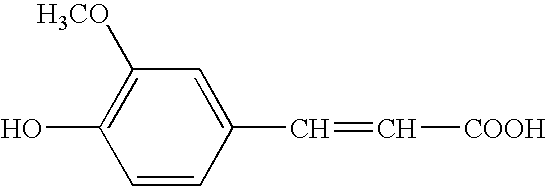Method of preventing flavor component from degradation
a technology of flavor components and preventive measures, which is applied in the field of flavor component deterioration preventive measures, can solve the problems of lowering the quality of citrus beverages, foodtuffs containing lactose components, and components that are more likely to deteriorate, and achieves excellent emulsification stability, excellent dispersibility in foodstuffs, and no effect of impairing appearance and tas
- Summary
- Abstract
- Description
- Claims
- Application Information
AI Technical Summary
Benefits of technology
Problems solved by technology
Method used
Image
Examples
example 1-1
[0080] As a polyhydric alcohol mixture, 2 g of pentaglycerol monomyristate (manufactured by Taiyo Kagaku Co., Ltd., HLB value: 14, pentaglycerol content in polyglycerol composition: 45%), which is a polyglycerol fatty acid ester, and 2 g of ferulic acid (ferulic acid content: 98% or more, manufactured by Tsuno Food Industrial Co., Ltd.) were added to 95 g of glycerol (manufactured by NOF Corporation), and the mixture was dissolved by heating the mixture to 65° C. One gram of extracted tocopherol (manufactured by Tama Biochemical Co., Ltd., d-δ-tocopherol content: 86%) was added as an oil phase to the polyhydric alcohol mixture, and the mixture was emulsified with a homomixer (manufactured by Tokushu Kika Kogyo Co., Ltd.) at a rotational speed of 7000 rpm, to give a deterioration preventive of the inventive product 1.
example 1-2
[0081] As a polyhydric alcohol mixture, 2 g of pentaglycerol monomyristate (manufactured by Taiyo Kagaku Co., Ltd., HLB value: 14, pentaglycerol content in polyglycerol composition: 45%), which is a polyglycerol fatty acid ester, 1 g of ferulic acid (ferulic acid content: 98% or more, manufactured by Tsuno Food Industrial Co., Ltd.) and 1 g of a green tea extract (trade name: SUNPHENON BG, catechin content: 70%, manufactured by Taiyo Kagaku Co., Ltd.) were added to 95 g of glycerol (manufactured by NOF Corporation), and the mixture was dissolved by heating the mixture to 65° C. One gram of extracted tocopherol (manufactured by Tama Biochemical Co., Ltd., δ-tocopherol content: 86%) was added as an oil phase to the polyhydric alcohol mixture, and the mixture was emulsified with a homomixer (manufactured by Tokushu Kika Kogyo Co., Ltd.) at a rotational speed of 7000 rpm, to give a deterioration preventive of the inventive product 2.
example 1-3
[0082] As a polyhydric alcohol mixture, 2 g of pentaglycerol monomyristate (manufactured by Taiyo Kagaku Co., Ltd., HLB value: 13, pentaglycerol content in polyglycerol composition: 15%), which is a polyglycerol fatty acid ester, 1 g of ferulic acid (ferulic acid content: 98% or more, manufactured by Tsuno Food Industrial Co., Ltd.) and 1 g of a green tea extract (trade name: SUNPHENON BG, catechin content: 70%, manufactured by Taiyo Kagaku Co., Ltd.) were added to 95 g of glycerol (manufactured by NOF Corporation), and the mixture was dissolved by heating the mixture to 65° C. One gram of extracted tocopherol (manufactured by Tama Biochemical Co., Ltd., δ-tocopherol content: 86%) was added as an oil phase to the polyhydric alcohol mixture, and the mixture was emulsified with a homomixer (manufactured by Tokushu Kika Kogyo Co., Ltd.) at a rotational speed of 7000 rpm, to give a deterioration preventive of the inventive product 3.
PUM
| Property | Measurement | Unit |
|---|---|---|
| particle size | aaaaa | aaaaa |
| particle size | aaaaa | aaaaa |
| particle size | aaaaa | aaaaa |
Abstract
Description
Claims
Application Information
 Login to View More
Login to View More - R&D
- Intellectual Property
- Life Sciences
- Materials
- Tech Scout
- Unparalleled Data Quality
- Higher Quality Content
- 60% Fewer Hallucinations
Browse by: Latest US Patents, China's latest patents, Technical Efficacy Thesaurus, Application Domain, Technology Topic, Popular Technical Reports.
© 2025 PatSnap. All rights reserved.Legal|Privacy policy|Modern Slavery Act Transparency Statement|Sitemap|About US| Contact US: help@patsnap.com

